|
January - August: |
|
ATY - M
Head, back and breast black, white and red
without brown juvenal feathers. Primary coverts
are either irregularly mixed with fresh and
moderately worn adult feathers OR are uniformly
dark and fresh. Iris reddish brown. Crown
primarily red, throat and chin are also red. |
 |
|
|
|
ATY - F
Head, back and breast black, white and red
without brown juvenal feathers. Primary coverts
are either irregularly mixed with fresh and
moderately worn adult feathers OR are uniformly
dark and fresh. Iris reddish brown. Crown
completely black OR primarily red (but less
extensive than males), throat and chin white
with the occasional few red feathers. |
|
|
|
|
TY - M
Head, back and breast black, white and red
without brown juvenal feathers. Outer few
primary coverts replaced (black), all other
retained primary coverts pale brown, OR all
primary coverts brown and abraded. Iris reddish
brown. Crown primarily red, throat and chin are
also red. |
|
|
|
|
TY - F
Head, back and breast black, white and red
without brown juvenal feathers. Outer few
primary coverts replaced (black), all other
retained primary coverts pale brown, OR all
primary coverts brown and abraded. Iris reddish
brown. Crown completely black OR primarily red
(but less extensive than males), throat and chin
white with the occasional few red feathers. |
|
|
|
|
SY - M
Head, back and upper breast a mix of brown
juvenal and adult feathers. Primary coverts
uniformly brown and contrast with the rest of
the wing. Crown primarily red, throat and chin
are also red. |
 |
 |
 |
|
SY - F
Head, back and upper breast a mix of brown
juvenal and adult feathers. Primary coverts
uniformly brown and contrast with the rest of
the wing. Crown completely black OR primarily
red (but less extensive than males), throat and
chin white with the occasional few red feathers. |
|
|
|
|
|
September - December: |
|
ASY - M
Head, back and breast black, white and red
without brown juvenal feathers. Primary coverts
are either irregularly mixed with fresh and
moderately worn adult feathers OR are uniformly
dark and fresh. Iris reddish brown. Crown
primarily red, throat and chin are also red. |
|
|
|
|
ASY - F
Head, back and breast black, white and red
without brown juvenal feathers. Primary coverts
are either irregularly mixed with fresh and
moderately worn adult feathers OR are uniformly
dark and fresh. Iris reddish brown. Crown
completely black OR primarily red (but less
extensive than males), throat and chin white
with the occasional few red feathers. |
|
|
|
|
SY - M
Head, back and breast black, white and red
without brown juvenal feathers. Outer few
primary coverts replaced (black), all other
retained primary coverts brown OR all primary
coverts brown and abraded. Crown primarily red,
throat and chin are also red. |
|
|
|
|
SY - F
Head, back and breast black, white and red
without brown juvenal feathers. Outer few
primary coverts replaced (black), all other
retained primary coverts brown OR all primary
coverts brown and abraded. Crown completely
black OR primarily red (but less extensive than
males), throat and chin white with the
occasional few red feathers. |
|
|
|
|
HY - M
Head, back and upper breast a mix of brown
juvenal and adult feathers. Primary coverts
paler brown than the rest of the wing. Iris
gray/brown. Crown primarily red, throat and chin
are also red. |
 |
 |
 |
|
HY - F/U
Head, back and upper breast a mix of brown
juvenal and adult feathers. Primary coverts
uniform, quickly becoming worn. Iris
gray/brown. Crown completely black OR primarily
red (but less extensive than males), throat and
chin white with the occasional few red feathers. |
 |
 |
 |
|
Ageing and sexing details:
Head, back
and breast are black white and/or red without brown juvenal feathers
(caution: adult feathers can be tipped brown). Crown primarily red,
throat and chin are also red.
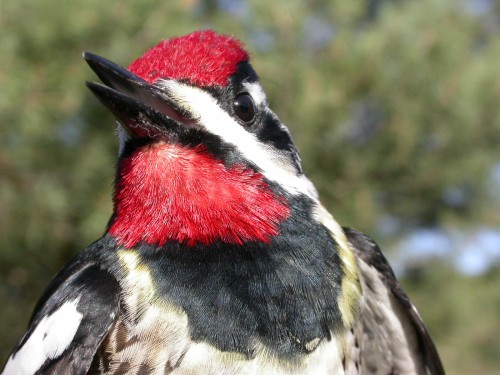
Photo by Marcel Gahbauer,
McGill Bird Observatory,
May 2005
Primary coverts are an irregular mix of fresh and relatively
worn adult feathers OR are uniformly dark and fresh. The secondaries
are uniformly adult OR have 1-6 older adult feathers (usually through
s1-s8), contrasting slightly with the rest of the replaced feathers.
This usually is not symmetrical in both wings. ATYs with uniform adult
flight feathers can possibly be aged A4Y, and ATYs with isolated
retained juvenal primary coverts or with 3 generations of primary
coverts consecutively replaced from the outside might be aged as 4Y or
even 5Y, but more study is needed.
Tails are not terribly useful for this age group.
RETURN TO AGE/SEX OVERVIEW
Head, back and breast are black white and/or red without
brown juvenal feathers (caution: adult feathers can be tipped brown).
Crown completely black OR primarily red (but less extensive than males),
throat and chin white with the occasional few red feathers.
Primary coverts are
an irregular mix of fresh and relatively worn adult feathers OR are
uniformly dark and fresh (this case is shown below). The secondaries
are uniformly adult OR have 1-6 older adult feathers (usually through
s1-s8), contrasting slightly with the rest of the replaced feathers.
This usually is not symmetrical in both wings. ATYs with uniform adult
flight feathers can possibly be aged A4Y, and ATYs with isolated
retained juvenal primary coverts or with 3 generations of primary
coverts consecutively replaced from the outside might be aged as 4Y or
even 5Y, but more study is needed.
Tails are
not terribly useful for this age group.
RETURN TO AGE/SEX OVERVIEW
Head, back and breast are black white and/or red without
brown juvenal feathers (caution: adult feathers can be tipped brown).
Crown primarily red, throat and chin are also red.
Primary coverts either retained juvenal
feathers, brown and very worn OR the outermost few primary coverts
contrastingly dark and fresh. The secondaries are usually a mix of
fresh (dark) and 1-6 retained (brown) juvenal feathers in a block.
These should be symmetrical in both wings, faded, abraded and
contrasting markedly with the fresher, replaced feathers. Some
intermediates are difficult to separate from ASY and should be aged as
AHY, especially those with strange moult patterns.
Tails are not especially helpful for this age
group.
RETURN TO AGE/SEX OVERVIEW
Head, back and breast are black white and/or red without brown juvenal
feathers (caution: adult feathers can be tipped brown). Crown
completely black OR primarily red (but less extensive than males),
throat and chin white with the occasional few red feathers.

Photo
by Simon Duval, McGill Bird Observatory, April 2008
Primary coverts
either retained juvenal feathers, brown and very worn OR the outermost
few primary coverts contrastingly dark and fresh. The secondaries are
usually a mix of fresh (dark) and 1-6 retained (brown) juvenal feathers
in a block. These should be symmetrical in both wings, faded, abraded
and contrasting markedly with the fresher, replaced feathers. Some
intermediates are difficult to separate from ASY and should be aged as
AHY, especially those with strange moult patterns.
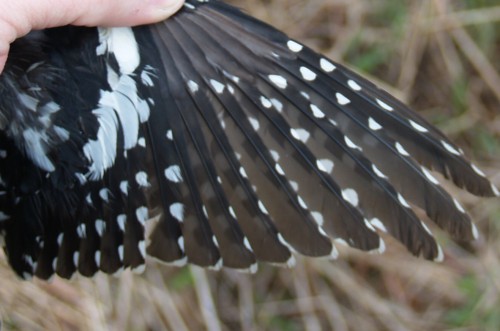
Photo by Simon Duval, McGill Bird Observatory, April 2008
Tails are not especially helpful for this age
group.
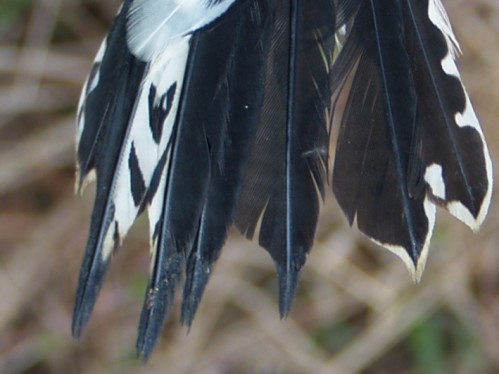
Photo
by Simon Duval, McGill Bird Observatory, April 2008
RETURN TO AGE/SEX OVERVIEW
Crown primarily red, throat and chin are also red.
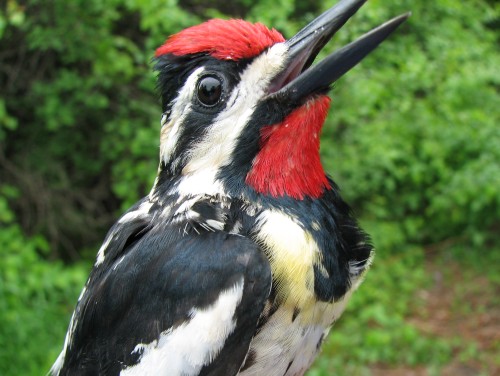
Photo by Barbara Frei,
McGill Bird Observatory,
May 2006
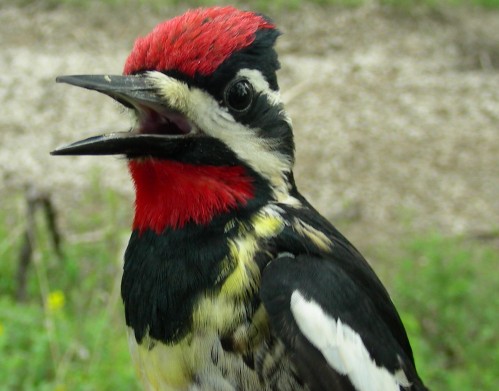
Photo
by Marcel Gahbauer, Dinosaur Provincial Park, May 2007
The first prebasic moult includes up to a few inner lesser
coverts and median coverts, and all primaries and rectrices. These
should all be replaced by August. Primary coverts are uniform in colour,
and by spring are usually brown, at least slightly paler than adjacent
black feather tracts.
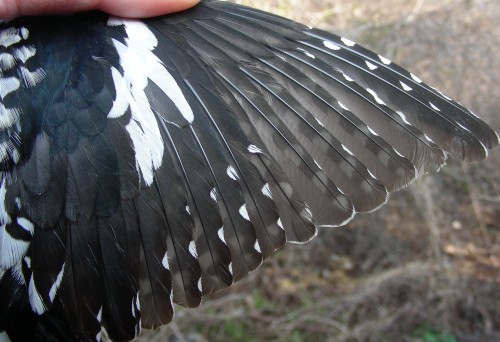
Photo by Marie-Anne Hudson, McGill Bird Observatory, April 2008
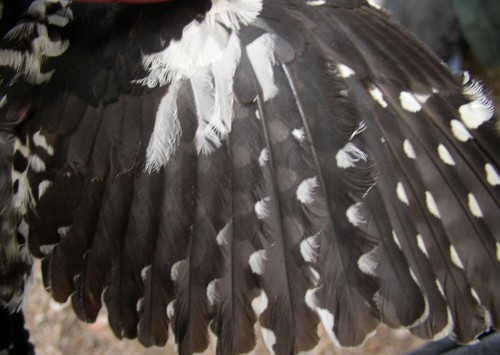
Photo
by Marcel Gahbauer, Dinosaur Provincial Park, May 2007
The first prebasic moult includes rectrices, so
look for a uniform tail in spring.
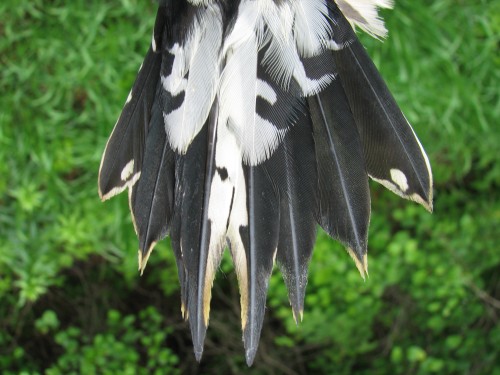
Photo by Barbara Frei,
McGill Bird Observatory,
May 2006
RETURN TO AGE/SEX OVERVIEW
Head, back and/or upper breast has a mix of brown juvenal
feathers and adult feathers, becoming fully adult by Dec-May (but
sometimes as late as the 2nd prebasic moult). Crown
completely black OR primarily red (but less extensive than males),
throat and chin white with the occasional few red feathers. The iris is
gray-brown to brown through January.
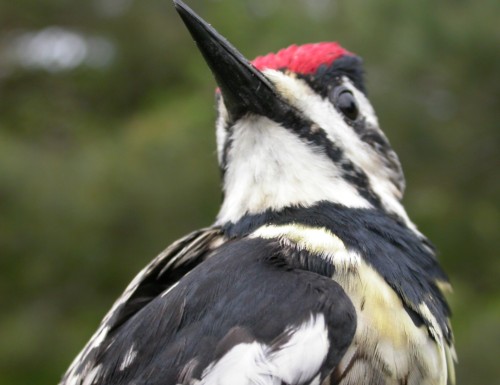
Photo
by Marcel Gahbauer, McGill Bird Observatory, May 2005
The first prebasic moult includes no to a few inner
lesser coverts and median coverts, and all primaries and rectrices.
These should all be replaced by August. Primary coverts are uniform in
colour, quickly becoming brown by winter/spring. Secondaries are also
uniform in colour, as are the tertials.
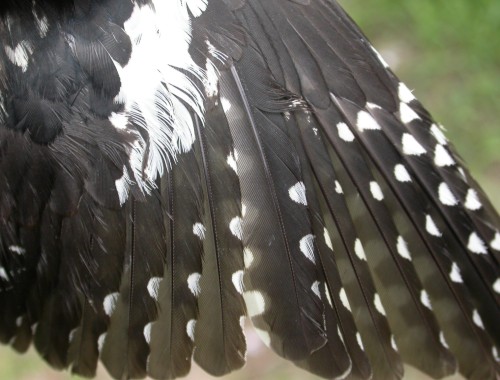
Photo
by Marcel Gahbauer, McGill Bird Observatory, May 2005
The first prebasic moult includes rectrices, so
look for a uniform tail in spring.

Photo
by Marcel Gahbauer, McGill Bird Observatory, May 2005
RETURN TO AGE/SEX OVERVIEW
Head, back and breast are black, white, and/or red without
brown juvenal feathers (caution: adult feathers can be tipped brown).
Crown primarily red, throat and chin are also red.
Primary coverts are an irregular mix of
fresh and relatively worn adult feathers OR are uniformly dark and
fresh. The secondaries are uniformly adult OR have 1-6 older adult
feathers (usually through s1-s8), contrasting slightly with the rest of
the replaced feathers. This usually is not symmetrical in both wings.
ASYs with uniform adult flight feathers can possibly be aged ATY, and
ASYs with isolated retained juvenal primary coverts or with 3
generations of primary coverts consecutively replaced from the outside
might be aged as TY or even 4Y, but more study is needed.
Tails are not especially helpful for this age
group.
RETURN TO AGE/SEX OVERVIEW
Head, back and breast are black white and/or red without
brown juvenal feathers (caution: adult feathers can be tipped brown).
Crown completely black OR primarily red (but less extensive than males),
throat and chin white with the occasional few red feathers.
Primary coverts are an irregular mix of
fresh and relatively worn adult feathers OR are uniformly dark and
fresh. The secondaries are uniformly adult OR have 1-6 older adult
feathers (usually through s1-s8), contrasting slightly with the rest of
the replaced feathers. This usually is not symmetrical in both wings.
ASYs with uniform adult flight feathers can possibly be aged ATY, and
ASYs with isolated retained juvenal primary coverts or with 3
generations of primary coverts consecutively replaced from the outside
might be aged as TY or even 4Y, but more study is needed.
Tails are not especially helpful for this age
group.
RETURN TO AGE/SEX OVERVIEW
Head, back and breast are black, white, and/or red without
brown juvenal feathers (caution: adult feathers can be tipped brown).
Crown primarily red, throat and chin are also red. The iris is
gray-brown to brown through January.
Outer few primary coverts replaced (black), all other
retained primary coverts brown. The secondaries are either uniformly
adult with fresh tertials OR may contain 1-4 retained juvenal feathers.
These should be symmetrical in both wings, faded, abraded and
contrasting markedly with the fresher, replaced feathers. Some
intermediates are difficult to separate from ASY and should be aged as
AHY.
Tails are not terribly useful for ageing or sexing woodpeckers.
RETURN TO AGE/SEX OVERVIEW
Head, back and
breast are black, white, and/or red without brown juvenal feathers
(caution: adult feathers can be tipped brown). Crown completely black
OR primarily red (but less extensive than males), throat and chin white
with the occasional few red feathers. The iris is gray-brown to brown
through January.
Primary coverts either retained juvenal
feathers, brown and very worn OR the outermost few primary coverts
contrastingly dark and fresh. The secondaries are usually a mix of
fresh (dark) and 1-6 retained (brown) juvenal feathers in a block.
These should be symmetrical in both wings, faded, abraded and
contrasting markedly with the fresher, replaced feathers. Some
intermediates are difficult to separate from ASY and should be aged as
AHY, especially those with strange moult patterns.
Tails are not especially helpful for this age
group.
RETURN TO AGE/SEX OVERVIEW
Head, back and/or upper breast has a mix of brown juvenal
feathers and adult feathers, becoming fully adult by Dec-May (but
sometimes as late as the 2nd prebasic moult). Crown
primarily red, throat and chin are also red. The iris is gray-brown to
brown through January.
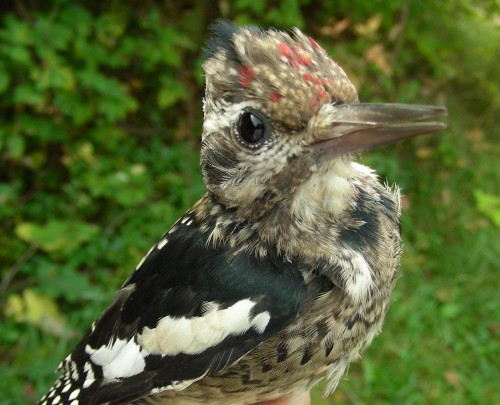
Photo
by Marie-Anne Hudson, McGill Bird Observatory, October 2007

Photo by Marie-Anne Hudson,
McGill Bird Observatory, August 2008
The first prebasic moult includes no to a few inner lesser
coverts and median coverts, and all primaries and rectrices. These
should all be replaced by August. Primary coverts are uniform in colour,
quickly becoming brown by winter/spring. Secondaries are also uniform
in colour, as are the tertials.
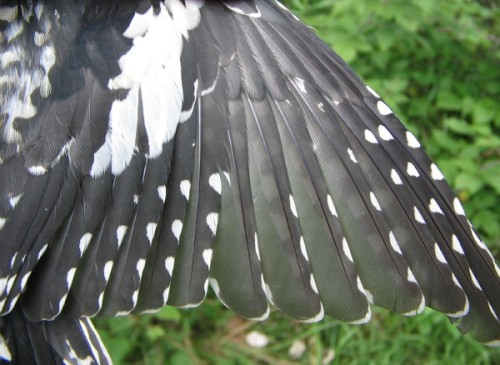
Photo by Marie-Anne Hudson,
McGill Bird Observatory,
September 2006
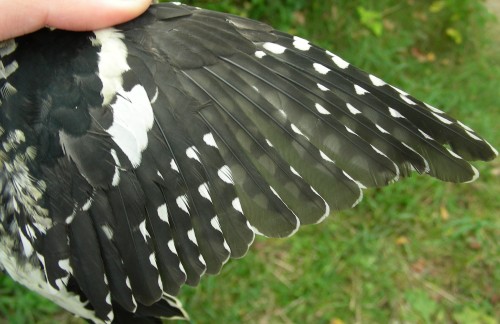
Photo
by Marie-Anne Hudson, McGill Bird Observatory, October 2007
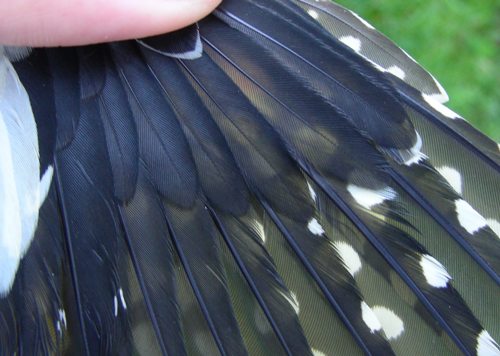
Photo
by Marie-Anne Hudson, McGill Bird Observatory, August 2008
The first prebasic moult includes rectrices, so
look for very fresh feathers after the moult completes in August, or a
mix of juvenal and HY feathers beforehand.
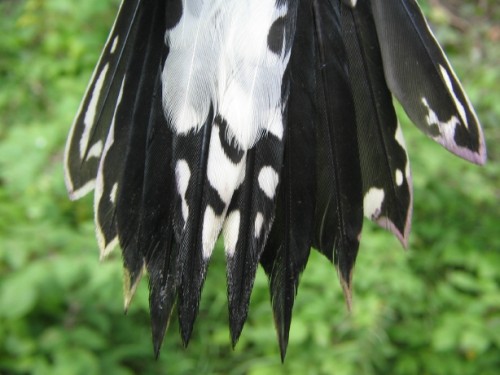
Photo by Marie-Anne Hudson,
McGill Bird Observatory,
September 2006
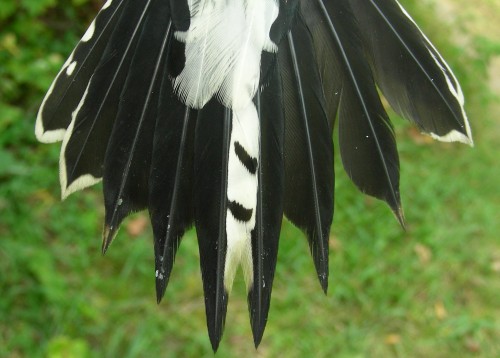
Photo
by Marie-Anne Hudson, McGill Bird Observatory, October 2007
RETURN TO AGE/SEX OVERVIEW
|
hatch-year female / unknown |
Head, back and/or upper breast has a mix of brown juvenal
feathers and adult feathers, becoming fully adult by Dec-May (but
sometimes as late as the 2nd prebasic moult). Crown
completely black OR primarily red (but less extensive than males),
throat and chin white with the occasional few red feathers. The iris is
gray-brown to brown through January.
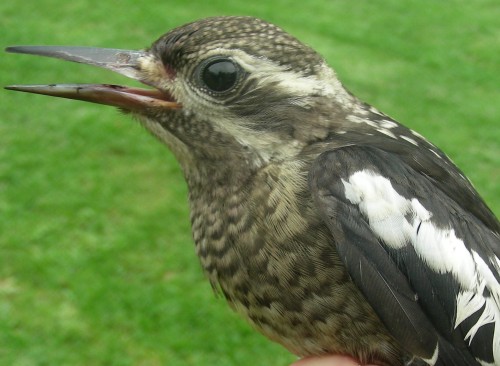
Photo
by Marie-Anne Hudson, McGill Bird Observatory, August 2007
The first prebasic moult includes no to a few inner lesser
coverts and median coverts, and all primaries and rectrices. These
should all be replaced by August. Primary coverts are uniform in colour,
quickly becoming brown by winter/spring. Secondaries are also uniform
in colour, as are the tertials.
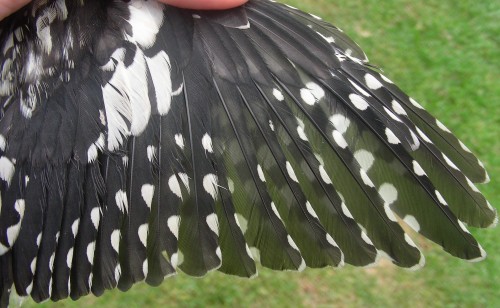
Photo
by Marie-Anne Hudson, McGill Bird Observatory, August 2007
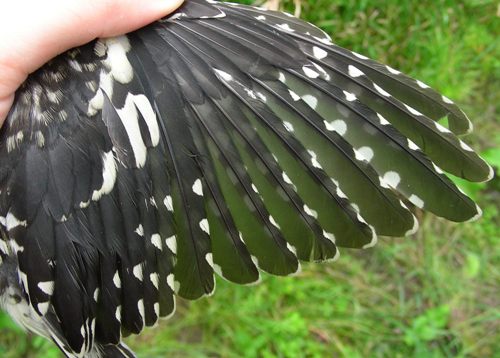
Photo
by Marie-Anne Hudson, McGill Bird Observatory, August 2008
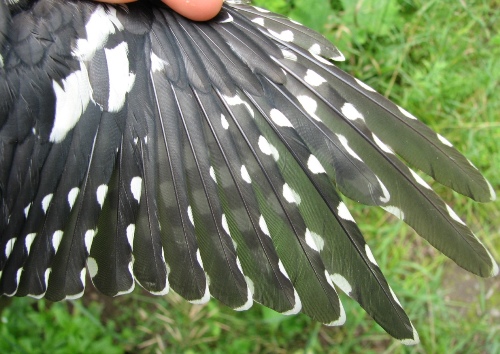
Photo
by Barbara Frei, McGill Bird Observatory, August 2008
The first prebasic moult includes rectrices, so
look for very fresh feathers after the moult completes in August, or a
mix of juvenal and HY feathers beforehand.
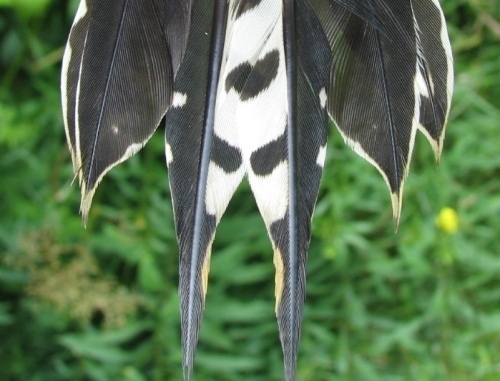
Photo
by Barbara Frei, McGill Bird Observatory, August 2008
RETURN
TO AGE/SEX OVERVIEW








































